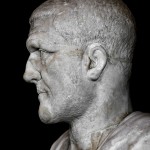by Adrienne Mayor (Wonders and Marvels contributor) 
In AD 235 a giant became the most powerful man in the Roman Empire. Maximinus of Thrace (Bulgaria) was a simple shepherd when his impressive size and strength attracted the attention of the Roman emperor in AD 202. Maximinus wrestled 16 of the emperor’s burliest soldiers. Then, only slightly winded, he raced the emperor’s horse and went on to overcome 7 more hefty legionnaires. The Thracian colossus was inducted into the army on the spot. Maximinus rose through the ranks, proving himself such a beloved leader that he was given supreme command of the imperial army. In AD 235 the army and the Senate proclaimed him Emperor of Rome.
Ancient Roman writers claimed that Maximinus Thrax stood over 8 feet tall. His sandals were said to be twice the size of regular army issue. He wore his wife’s bracelet as a thumb ring. It was said he devoured 40 pounds of meat and 18 bottles of wine at each meal. They claimed he crushed rocks in his fists, out-pulled a team of horses, and knocked out a mule with one punch. These are all exaggerations, of course. Unless his skeleton is discovered someday in a coffin, his exact size remains unknown. But the detailed descriptions of his appearance and portrait busts suggest that the huge Bulgarian probably suffered from a form of acromegaly. Of “frightening appearance and colossal size,” he displayed a prominent forehead, large nose, and lantern jaw, typical symptoms of pituitary gland overproduction of growth hormones.
Most sufferers of gigantism do not live long lives, but Maximinus died at age 65 in AD 238. He might have lived longer, but during his reign, his popularity plummeted. Of humble barbarian origins, he hated Roman aristocrats and became paranoid and brutal. The public turned against him, taunting him with the nickname “Cyclops.” During an unsuccessful siege, his soldiers turned against him. Maximinus was assassinated as he slept on his immense cot in his tent by his own Praetorian guards.
About the author: Adrienne Mayor is a Research Scholar in Classics and History of Science, Stanford University. She is the author of “Greek Fire, Poison Arrows, & Scorpion Bombs: Biological and Chemical Warfare in the Ancient World” (2009); and “The Poison King: The Life and Legend of Mithradates, Rome’s Deadliest Enemy,” a nonfiction finalist for the 2009 National Book Award.
